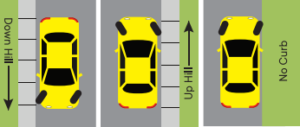California’s Parking Laws & Regulations
Written By | Doreen Almirol | 20+ years CA DMV Licensed Driving Instructor
In the diverse landscape of California, understanding the intricacies of parking regulations is essential for every driver. From parallel parking techniques to specific rules for parking on hills and at colored curbs, this guide will break down the details using the California Driver Handbook as our reference.
This blog may contain affiliate links, and if you make a purchase through these links, we may or may not earn a commission at no extra cost to you.
1 | Parallel Parking Protocol
Parallel parking is a skill every California driver should master. Here’s a step-by-step guide as outlined in the California Driver Handbook:
- Find a Suitable Space: Identify a spot at least three feet longer than your vehicle and activate your turn signal to signal your intent to park.
- Align with the Front Vehicle: Pull up alongside the vehicle in front of the chosen space, leaving about two feet between your vehicle and the adjacent one.
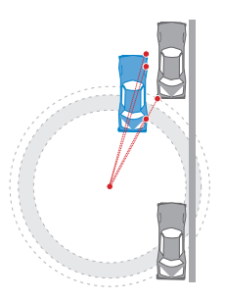
- Check Blind Spots: Ensure the coast is clear by checking your blind spots for approaching vehicles and pedestrians.
- Back In at a 45-Degree Angle: Begin backing up, turning your steering wheel to achieve a 45-degree angle into the parking space.
- Straighten Out: Adjust the steering wheel when your rear wheel is within 18 inches of the curb, ensuring your vehicle is parallel and within the specified distance.
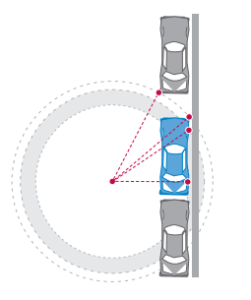
- Secure Parking: Turn off your vehicle, engage the parking brake, and exit cautiously after checking for passing vehicles, bicycles, and motorcycles.
2 | Straight Line Backing
Backing up in a straight line is another crucial skill. Follow these steps:
- Traffic Check: Observe traffic and check blind spots before initiating the backing process.
- Signal Appropriately: Activate your turn signal before pulling up to the curb, canceling it once the maneuver is complete.
- Back Up Smoothly: Back in a straight line for three vehicle lengths, staying within three feet of the curb. Maintain a safe speed and adjust the steering wheel as needed.
- Control and Departure: Practice until you can back up smoothly. Repeat steps 1 and 2 when pulling away from the curb.
3 | Parking on a Hill
Parking on an incline requires special attention to prevent your vehicle from rolling. Follow these guidelines:
- Headed Downhill: Turn front wheels into the curb or right toward the side of the road.
- Headed Uphill: Turn front wheels away from the curb (left) and let the vehicle roll back slightly, ensuring the wheel gently touches the curb.
- Uphill or Downhill with No Curb: Turn wheels to roll away from the center of the road if brakes fail.
- Sloping Driveway: Turn wheels to prevent rolling into the street, leaving the vehicle in gear and applying the parking brake.
4 | Parking at Colored Curbs
Understanding the meaning of colored curbs is crucial for compliance with specific parking rules:
- White: Stop briefly for passenger pick-up or drop-off.
- Green: Park for a limited time, with the time limit usually posted on signs or painted on the curb.
- Yellow: Load and unload passengers and freight within the specified time limit. Non-commercial vehicle drivers are usually required to stay with their vehicles.
- Red: Strictly no stopping, standing, or parking.
- Blue: Reserved for disabled parking with a special placard or license plate.
4 | Illegal Parking
Avoid fines and inconvenience by steering clear of these prohibited parking actions:
-
No Parking Zones: Respect areas with posted No Parking signs.
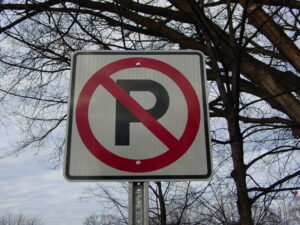
-
Crosswalks, Sidewalks, and Driveways: Keep a safe distance and avoid obstructing these essential spaces.
-
Disabled Parking Spaces: Stay clear of designated spaces and the crosshatched area next to them.

-
Zero-Emission Vehicle Spaces: Unless driving a zero-emission vehicle, refrain from parking in designated spaces.
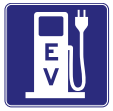
-
Tunnels and Bridges: Unless permitted by signs, avoid parking on tunnels or bridges.
-
Fire Hydrants: Keep a 15-foot distance to allow quick access for emergency vehicles.
-
Safety Zones: Avoid parking between a safety zone and the curb.
-
Double Parking: Never park beside an already parked vehicle.
-
Wrong Side of the Street or Freeway: Exceptions only apply in emergencies, law enforcement requirements, or where specifically permitted.
-
Freeway Stops: If stopping on a freeway, park completely off the pavement and remain in your locked vehicle until help arrives.
Mastering California’s parking regulations is an essential aspect of responsible driving. By following the guidelines outlined in the California Driver Handbook, you can navigate the streets with confidence, avoiding fines and contributing to a safer and more organized driving environment. Remember, staying informed about parking regulations not only protects your wallet but also ensures the well-being of fellow road users. Drive responsibly and park with precision to make the most of your Californian driving experience.



